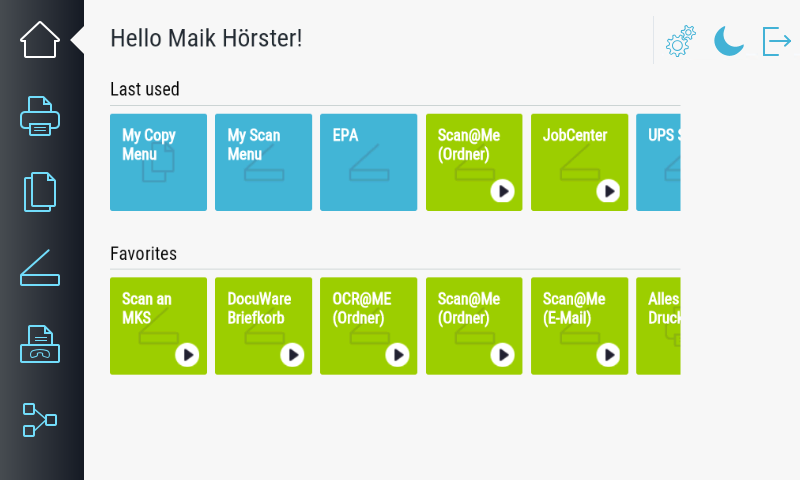Home screen
After logging in, you are in the home screen, which welcomes you by name. Here you can see your most recently used functions and your favorite functions and workflows, see My Workflows.
 To log out, you can press the Logout icon located in the upper right corner of each dialog. This will take you back to the default login screen (which one that is can be set under Set authentication methods).
To log out, you can press the Logout icon located in the upper right corner of each dialog. This will take you back to the default login screen (which one that is can be set under Set authentication methods).
 The Settings button takes you to your personal settings, where you can set the language. With some device manufacturers, you can get there directly; with some, a menu opens which gives you to access the settings. In this menu, the status dialog of the device can also be called up using Device Status.
The Settings button takes you to your personal settings, where you can set the language. With some device manufacturers, you can get there directly; with some, a menu opens which gives you to access the settings. In this menu, the status dialog of the device can also be called up using Device Status.
After logging in, the device will automatically switch to the language you have set. Depending on the system settings, you also have the option here of linking a transponder card with your user, see Card learning.
If you have the user right Use Device Function, you can close the interface of IQ4docs and go to the device interface (this is the same as the function Device Function in the Copy area, however, depending on the license of the device, the copy dialog is not always displayed).
This function is used to call up the Status device interface, in which print jobs can be viewed and paused. Technicians can also access the technician menu of the device via this menu.
If the device has to be made available with full rights for a technician, the maintenance password can be entered via this menu item, see also Unlock Device With Service Password.
If you have administrator rights to the device (see User List), you can open another dialog by pressing the Settings button for a longer time. This dialog provides you with information about the device and about the settings and versions of the Embedded Client and DeviceService. Additionally you have the following buttons:
- Save log file to USB: The IQ4docs log file is written to a USB medium plugged into the device (log_<timestamp>_<device_serial_number>.log, e.g. log_20171115_160457_W2S6801632.log). The log file can have a maximum size of 2 MB. The write operation is started immediately when the button is pressed and is also ended without a message (takes only a few seconds).
- Close application window: Closes the Embedded Client interface (displays the interface of the device).
 With some device manufacturers, pressing this icon activates the device's energy-saving mode and turns off the display. If you are currently logged in, you will be logged out by this process.
With some device manufacturers, pressing this icon activates the device's energy-saving mode and turns off the display. If you are currently logged in, you will be logged out by this process.
The menu on the left side of the screen offers icons to jump to the dialogs explained below. The arrow marks the currently displayed dialog (icon turns white). The menu icons Print, Copy, Scan and Fax call up the respective workflow defined as the standard for a type, see also Workflow Settings.

|
Opens the home screen described here. |

|
Opens the standard print workflow, see My Print Jobs. |

|
Opens the standard copy workflow, see My Copy Menu. |

|
Opens the standard scan workflow, see My Scan Menu. |

|
Opens the standard fax workflow (this function can be deactivated, e.g. if the device has no fax function and no fax server is available - the icon is then not visible), see My Fax Menu. |

|
Displays your personal workflows, see My Workflows. |
In the Last Used area, you can access all the functions you have used recently. The list contains a maximum of 20 entries (when a new entry is made, the oldest one is deleted).
 Mark functions as favorites by pressing the star symbol. These can be standard functions or workflows you have created yourself. They are displayed in Home screen under Favorites. If the list of favorites is longer than the screen is wide, swipe your finger horizontally over the favorites (a maximum of 20 favorites is possible). Press the star symbol again to remove the function from the favorites.
Mark functions as favorites by pressing the star symbol. These can be standard functions or workflows you have created yourself. They are displayed in Home screen under Favorites. If the list of favorites is longer than the screen is wide, swipe your finger horizontally over the favorites (a maximum of 20 favorites is possible). Press the star symbol again to remove the function from the favorites.
Depending on the system settings, this function might not be available.
